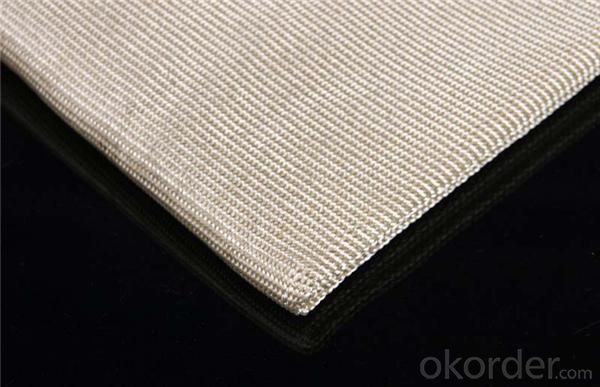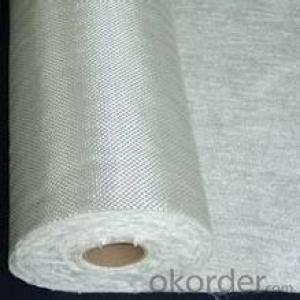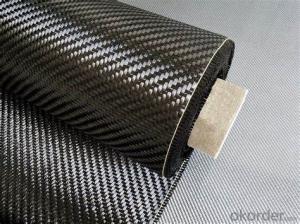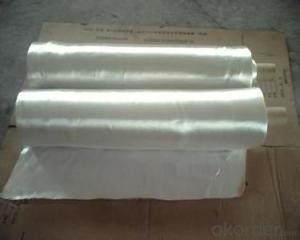Fiberglass Fabrics with Silica Fabric Superb Electronic Insulation and High Texturization
- Loading Port:
- China Main Port
- Payment Terms:
- TT or LC
- Min Order Qty:
- 20 m²
- Supply Capability:
- -
OKorder Service Pledge
OKorder Financial Service
You Might Also Like
1.Brief Introduction:
High silica texturized fabrics can be used for a long period of time without changing their properties perat the temperature of 1000℃ as it contains more than 96% silica.The performance of thermal insulation is excellent because of its texturized structure.

2.Properties
No asbestos orceramic,no harm to human
Low thermal conductivity,excellent thermal insulation,high resistance to thermal shock
Superb electric insulation
Inert to majority of chemical reagents

3.Application
Thermal insulation and protection for heavy machinery
Thermal insulation and protection for shipbuilding
Thermal insulation material for turbine
Thermal insulation and protection for metallurgy

Specifications:
| Product Code | Area Weight gsm | Width cm | Thickness mm | SiO2 | OperatingTemperature ℃ |
| STP-600 | 600±30 | 100±1 | 0.8±0.05 | ≥96 | 1000 |
| STP-900 | 880±30 | 100±1 | 1.2±0.05 | ≥96 | 1000 |
Package:
Packed with carton and pallets.
FAQ:
1.What is the delivery time ?
15days after receiving the deposit
2.Are you a trading company or factory.
We are factory,and we have more than 10 years of experience.
- Q: What is the typical thickness range for fiberglass fabrics?
- The typical thickness range for fiberglass fabrics is between 0.1mm to 3mm.
- Q: Can fiberglass fabric be used for making gaskets?
- Indeed, the utilization of fiberglass fabric is applicable in the production of gaskets. Renowned for its exceptional durability and ability to endure high temperatures, fiberglass fabric emerges as an optimal material for gaskets necessitating resilience against intense heat and pressure. This fabric guarantees a dependable seal and finds frequent application in domains demanding chemical resistance and long-lasting performance, including the automotive, aerospace, and industrial sectors. Moreover, the lightweight and flexible nature of fiberglass fabric enables effortless installation and facilitates adaptability to diverse gasket configurations.
- Q: How is fiberglass fabric used in the production of composites?
- Fiberglass fabric is a critical component in the production of composites, particularly in industries such as aerospace, automotive, construction, and marine. Composites are materials made by combining two or more different components, with fiberglass fabric being one of the most commonly used reinforcing materials. In the production process, fiberglass fabric is typically combined with a matrix material, such as resin, to create a composite structure. The fabric itself is made up of thin strands of glass fibers that are woven together to form a flexible and strong fabric. These glass fibers provide the reinforcement and strength to the composite material, making it highly durable and resistant to various external forces. One of the key advantages of using fiberglass fabric in composites is its excellent tensile strength. The woven structure of the fabric ensures that the load is spread evenly across the composite material, making it capable of withstanding high levels of stress and preventing cracks or fractures. This property is particularly beneficial in applications where lightweight yet strong materials are required. Moreover, fiberglass fabric offers exceptional resistance to corrosion, chemicals, and extreme temperatures. This makes composites reinforced with fiberglass fabric suitable for use in harsh environments where traditional materials may fail. For example, fiberglass composites are commonly used in the construction of aircraft and boats as they can withstand the corrosive effects of saltwater and harsh weather conditions. Fiberglass fabric is also highly versatile and can be tailored to meet specific requirements. It can be manufactured in various thicknesses, weaves, and finishes, allowing manufacturers to customize the fabric to suit the desired application. Additionally, it can be combined with other reinforcing materials, such as carbon fiber or kevlar, to create hybrid composites that possess a unique combination of properties. In summary, fiberglass fabric plays a vital role in the production of composites by providing strength, durability, and resistance to various environmental factors. Its versatility and ability to be customized make it a preferred choice for numerous industries seeking lightweight yet robust materials.
- Q: Are there any specific fire-resistant properties associated with fiberglass fabrics?
- Yes, fiberglass fabrics have inherent fire-resistant properties. They do not support combustion and are resistant to heat, making them suitable for various applications where fire safety is a concern.
- Q: How does fiberglass fabric perform in thermal conductivity?
- Fiberglass fabric has relatively low thermal conductivity, meaning it is a poor conductor of heat. This property makes it an excellent insulating material. The structure of fiberglass fabric consists of fine glass fibers, which have low thermal conductivity due to their low density and lack of metallic components. As a result, fiberglass fabric can effectively resist the transfer of heat, keeping the temperature on one side of the fabric from affecting the other side. This makes it suitable for applications where thermal insulation is required, such as in the construction of thermal blankets, oven insulation, or as a lining for industrial equipment. Additionally, the low thermal conductivity of fiberglass fabric contributes to its fire-resistant properties, as it does not readily transfer heat to ignite or support combustion. Overall, fiberglass fabric performs well in thermal conductivity by providing insulation and fire resistance.
- Q: How much glass fiber cloth and how much epoxy resin does it take to make a square meter of fiberglass?
- However, these data are probably different, each kind of resin viscosity (thin consistency), the more concentrated the resin will use more, and alkali content of different fiber, eat the amount of resin will be different, good eating fiber resin will be a little less.
- Q: How is fiberglass fabric used in automotive applications?
- The automotive industry commonly utilizes fiberglass fabric for various purposes in vehicles. This is because fiberglass fabric has a high strength-to-weight ratio, is highly durable, and is resistant to corrosion. It is primarily used to reinforce automotive components, providing structural support and enhancing their overall strength. One of the main ways fiberglass fabric is used in automotive applications is in the manufacturing of body panels, such as hoods, roofs, and fenders. By incorporating fiberglass into these panels, manufacturers are able to reduce the vehicle's weight, which improves fuel efficiency and overall performance. Additionally, fiberglass body panels are more durable than traditional metal panels, as they are highly resistant to dents and scratches. Fiberglass fabric is also extensively employed in the production of automotive interiors. It is commonly used in the development of headliners, door panels, and trunk liners, among other interior components. Fiberglass fabric is advantageous for these components because it provides stiffness and structural integrity, ensuring a longer lifespan and improved aesthetics. Another important application of fiberglass fabric in the automotive industry is in the manufacturing of reinforced plastic parts. Manufacturers combine fiberglass fabric with plastic resins to create strong and lightweight components that are resistant to impact and vibration. These reinforced plastic parts can be found in various automotive systems, including bumpers, spoilers, and air ducts. Furthermore, fiberglass fabric plays a crucial role in the production of automotive insulation materials. It is used to create heat shields, exhaust wraps, and soundproofing materials. These applications rely on the excellent thermal and acoustic insulation properties of fiberglass fabric to protect the vehicle and provide a comfortable driving experience. In conclusion, fiberglass fabric is extensively used in automotive applications because of its strength, durability, and resistance to corrosion. It is employed in body panels, interior components, reinforced plastic parts, and insulation materials, which contribute to improved vehicle performance, fuel efficiency, and overall comfort.
- Q: What color steel plate is good for dust-free workshop?
- Polyurethane sandwich panel consists of upper and lower intermediate color steel polyurethane foam composition, is one of the widely used building materials in the construction industry, has good thermal insulation, sound insulation, fire prevention materials added non combustion polyurethane. The polyurethane sandwich board has the advantages of non burning, moisture resistance, moth resistance, sound insulation, light weight, dry and wet, no deformation and heat preservation effect, and can be nailed, sawed and constructed, which is simple and convenient, and can be used repeatedly.
- Q: How to distinguish the good and bad of aluminum foil glass fiber cloth? What is the plain glass fiber cloth, glass fiber cloth and twill satin glass cloth?
- Satin glass cloth. Is referred to as a variety of satin glass fiber cloth organization. Including all kinds of glass fiber cloth satin and sateen change organization, different specifications of different styles of fabric.
- Q: Can fiberglass fabric be used for reinforcement in sporting goods?
- Yes, fiberglass fabric can be used for reinforcement in sporting goods. It is commonly used to enhance the durability, strength, and rigidity of various sporting equipment such as kayaks, surfboards, skis, and hockey sticks. The lightweight and high tensile strength properties of fiberglass make it an ideal material for reinforcing these products, improving their performance and longevity.
Send your message to us
Fiberglass Fabrics with Silica Fabric Superb Electronic Insulation and High Texturization
- Loading Port:
- China Main Port
- Payment Terms:
- TT or LC
- Min Order Qty:
- 20 m²
- Supply Capability:
- -
OKorder Service Pledge
OKorder Financial Service
Similar products
Hot products
Hot Searches
Related keywords






























